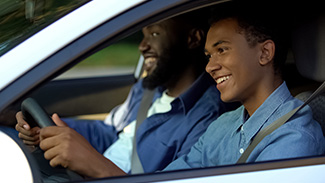
Teen Driver Safety Video
September 2023We're here to help your teen become a safer driver with these thoughtful tips.
Each year, thousands of motorists are killed and hundreds of thousands more are injured due to distraction-related crashes. In 2022, 12% of all fatal accidents related to distracted driving involved texting or cell phone use.1
Phones clearly aren't the only potential distractions while driving. However, there is ample evidence that cell phone use dramatically increases accident risk for drivers of all ages, and especially for young drivers.
Here's why phones are so distracting, how they increase accident risk, and tips for distraction-free driving when it comes to calls and texts.
![]()
When a driver looks at anything other than the road
![]()
When a driver takes one or both hands off the wheel
![]()
When emotions dictate driving behavior or disrupt focus
It can take at least three times as long for a texting driver to respond than a safe and attentive driver. With sudden changes in traffic and road conditions, and sharing the road with cyclists and pedestrians, one text has the potential to cause lasting damage to yourself and others.
Here's how many additional feet are needed to brake (in dry road conditions)3:

![]()
(It takes 5 seconds to send 1 text)4,5
![]()
(6-8x more likely for teen drivers)6,7
![]()
(6-8x more likely for teen drivers)6,7
Distraction can lead to something called "inattention blindness." This means that even if you're looking at the road while doing something else, such as talking on the phone, your brain can still fail to comprehend or process information about objects or road conditions ahead. In other words, you can be looking at something but not able to see it.8
Following a distracting activity, it takes drivers about 27 seconds, to be fully engaged in driving again.9 Think about how far you can drive in 27 seconds going 55mph! We won't make you do the math, but here's a hint: In just 5 seconds, you travel the length of a football field—and with inattention blindness, you're essentially driving blindfolded.
Being an informed and responsible driver helps reduce the risks of accidents for yourself and also for other drivers and pedestrians.10
The information we share on our site is intended to serve as a general overview. Please refer to your policy or contact your local independent agent for specific coverage details.

We're here to help your teen become a safer driver with these thoughtful tips.

Thousands of distraction-related crashes happen every year. Here are 8 ways to prevent distracted driving and be safe on the road.

Even if you're experienced driving in harsh winter conditions, it's easy to find yourself stuck or stalled. Here are some tips to prevent trouble.
Help your teen become a safer driver and receive a discount on your policy for drivers up to the age of 21.